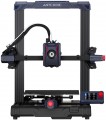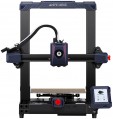Print speed
The print speed provided by an FDM/FFF type 3D printer (see "Print Technology").
The print speed in this case is the maximum amount of material that can pass through a regular nozzle per second. The higher this value (
150 mm/s,
180 mm/s ,
200 mm/s and
above), the faster the printer is able to cope with a particular task. Of course, the actual production time will depend on the configuration of the printing model and the print settings, but other things being equal, a printer with a higher speed will operate faster. On the other hand, an increase in speed requires an increase in heating power (because the extruder has time to melt the required volume of material), blowing power (otherwise the plastic will not have time to solidify normally), as well as stricter control of the movement of the extruder (to compensate for inertia from fast movements). So, generally, this spec strongly depends on the price category and specialization of the device, and it’s worth looking specifically for a “fast” model in cases where the speed of production is critical. Otherwise, a
100 mm/s model or
120 mm/s is sufficient, or even less.
Features
Additional features of the printer.
The list of the most popular features in modern 3D printers includes, in particular, a
heated bed,
a closed chamber,
object scanning,
a built-in camera, an
LCD display (including
touch),
filament sensor, as well as
resuming print function. Here is a more detailed description of these features:
— Heated bed. The availability of heating in the printing platform — the surface that is used as a support for the model to be built. This feature is found mainly in FDM/FFF printers (see "Printing Technology") and similar. The heated table ensures smooth and uniform cooling of the material, reducing the chance of deformations in completed models; this is especially important using materials with significant shrinkage. Also note that this feature is especially effective when combined with a closed print chamber (see below).
— Closed chamber. Operating area with a closed design. The specific designof such a chamber can be different — from a platform fenced on four sides to a sealed compartment where you can even create a vacuum for some specific printing methods. These nuances should be clarified separately. Anyway, the closed chamber protects the pr
...inted product from dust, moisture and other contaminants; but the more specific meaning of this feature may be different — depending on the printing technology (see above). So, in FFF/FDM printers and similar devices, the closed design allows to achieve more uniform cooling of the workpiece and avoids deformation due to material shrinkage. And almost all SLA and DLP units have such a design — even in the simplest models of this category, the operating area is covered at least with a light filter that protects the user from bright light.
— Object scanning. Built-in 3D scanner that allows you to create “digital masks” of various objects. The printer can recreate then a copy of the scanned item, based on that masks. This function actually turns the device into a three-dimensional copier: the user does not need to build a model in a CAD programme, it is enough to have a sample for copying. However, if necessary, the digital image can be edited — usually, the scanner allows you to transfer the received data to the same CAD programs.
— Built-in camera. Own digital camera installed directly into the printer and aimed at the operating area. Designed to capture the workflow; most often it allows you to shoot both photos and videos, but it's ok to clarify the specific shooting capabilities separately. Regarding the use of cameras, it is worth noting that printers with such equipment usually also have Wi-Fi modules and/or LAN network connectivity (see "Data Transfer"). This allows you to transfer the captured video over a local network or even over the Internet (these details, again, should be clarified for each model), and further use of the footage depends primarily on the user's desire. One of the most popular ways to use this is remote control of printing: if you have a camera, you can monitor the process without having to go to the printer once again. In addition, the data from the camera (live or recorded) can be used as a demonstration, as a visual aid for training/instruction, etc.
— Resume printing. A feature that allows you to continue the printing process after it has been stopped. It is useful primarily in cases where the printer is used at strictly defined hours — for example, during working hours; it can also come in handy if the printer is turned off due to a power failure. The second option is fairly obvious; and regarding the first, we should remind that 3D printing is a rather continuous process, and the creation of even a small product takes hours. Because of this, situations often arise when a work day (or other similar period of time) is not enough to complete the work. In such situations, the resume printing feature is useful: the printer can be paused for the duration of the absence, and to resume the process with returning to the printer. However, it should be noted that operating with some filaments, interruptions in work are undesirable; so if you plan to use this function, it's ok to clarify its compatibility with the preferred filament.
— Filament sensor. Sensor for controlling the supply of plastic filament during the printing process. As a rule, such a sensor is installed on the extruder (print head). If the filament suddenly runs out or its supply is interrupted, the sensor will prevent the print from failing due to lack of material - if it detects a lack of filament, it transmits a signal to stop the print so that the user can add filament and resume the process.LCD display
The printer has its own screen. The specific functionality of such a screen can be different - from the simplest indicator for several characters and service symbols to a full-fledged color matrix capable of displaying inscriptions, drawings, etc.; These nuances should be clarified separately. However, in any case, this feature provides additional ease of management: various service information can be displayed on the screen to help the user set up printing parameters and control the process.
We would like to emphasize that touch displays are not included in this category; they are indicated as a separate function. But the screen size directly affects the comfort when working with the device.
There are also models with a touch screen, similar to those used in smartphones and tablets. Such a display is a full-fledged control tool, and it is more convenient and functional than more traditional options such as keypads: you can display a wide variety of control elements (buttons, sliders, lists, etc.) on the screen, selecting the optimal set of these elements for your needs. specific situation. In addition, the screen itself usually has a color matrix with a fairly high resolution, which makes it possible to display a wide variety of service data - even drawings and diagrams. Thanks to all this, most printer control functions can be performed through such a display; some models with such equipment are able to work even without connecting to a computer. The disad...vantages of touch displays include their higher cost than conventional ones, despite the fact that control via a computer is usually still more practical and visual. So this function is relatively rare these days.

